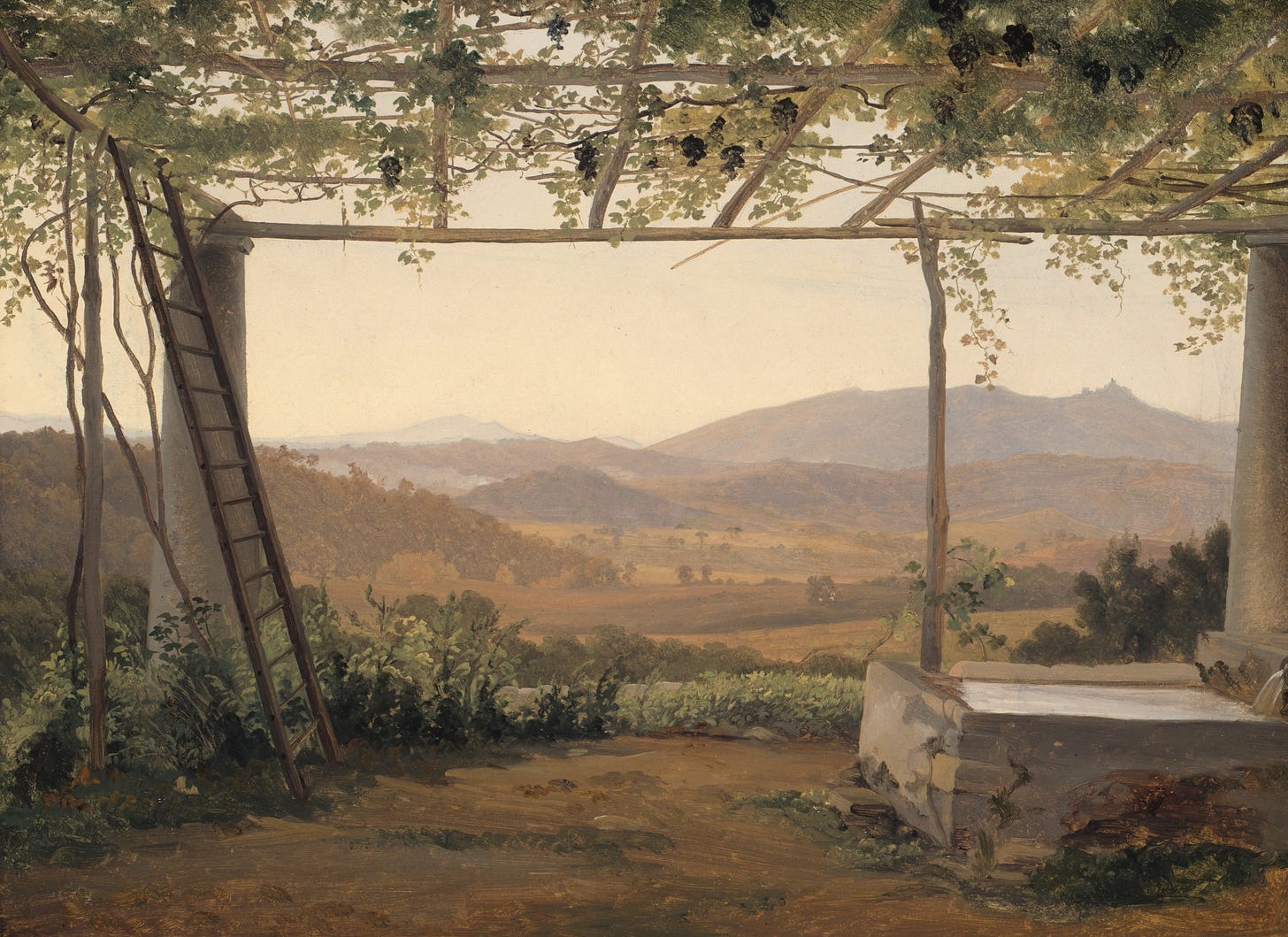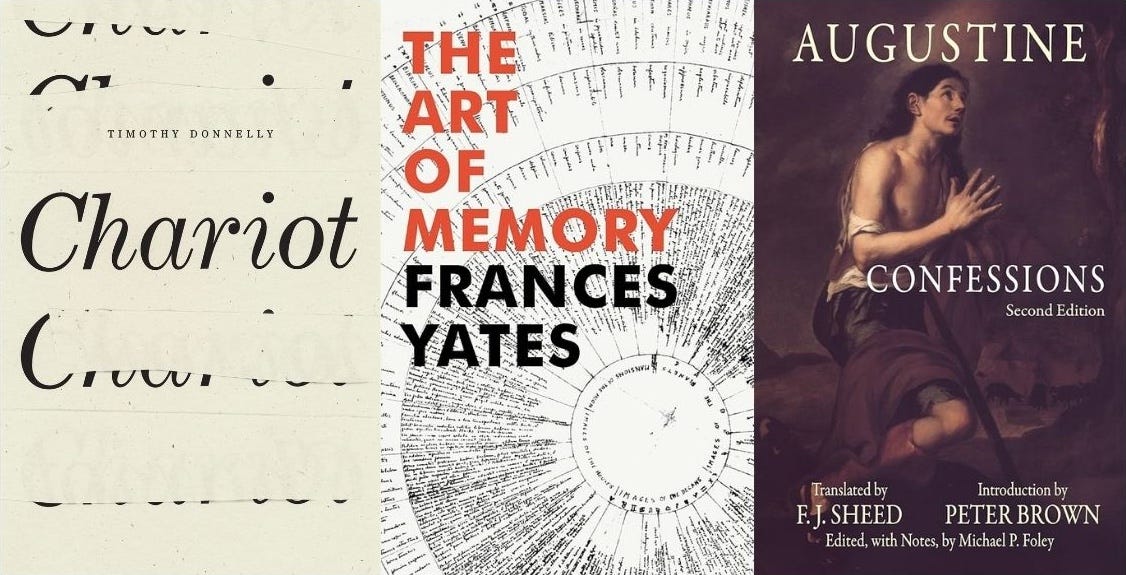
Last summer in Italy, I explored the extensive gardens attached to the Medici palace in Florence. The palace itself was dazzling, excessive: hall after all of tapestried walls and gilded ceilings frescoed with angels and nymphs, gods and heroes, all glaring down at me, a meager traveller in a profane century. I walked beside casually hung Botticellis and Caravaggios, past tables and armoires glinting with elaborate inlays of lapis, jasper, and mother of pearl. The details staggered me, and after an hour I was grateful to emerge again into the blinding sun of the courtyard, the bare stone walls enclosing a blank square of dirt.
Behind the palace, ascending the Tuscan hills away from the city, were the Medici gardens I’d really come to see. During the Renaissance, gardens were one of the ways powerful families flaunted their wealth. Growing exotic plant species showed the geographic extent of your power. Fountains shooting water high in the air demonstrated the skill of the engineers in your employ (and in your army). The amount of land you could afford to cultivate for pleasure rather than crops implied the gold in your coffers.
The Medici gardens are unsurprisingly lavish: over a hundred acres of terraced greenery including an amphitheater, cypress forest, citrus grove, multiple fountains, and dozens of statues. By the time I approached the Ocean Fountain—a round, fifty-foot pool with muscular Neptune rising at the center—clouds had moved in and a light rain had begun to fall. The pool lay ringed by thirty-foot hedges blocking the rest of the world from view. Two narrow causeways, lined with rose bushes and lemon trees, led across the water toward the sea god. Smaller statues of harpies, river spirits, and Capricorns perched on stone plinths. Perseus rose on horseback from the pool. Andromeda reached to him from her rocky outcrop. Raindrops dimpled the water with rings upon rings of ripples. Even now I can smell the lemon trees.
I remembered the gardens a few days ago as I read Francis Yates’ book, The Art of Memory. Yates traces the history of mnemonics, the ancient art of memorizing vast sequences of information. Aristotle and Cicero both wrote about it within the field of rhetoric, because mnemonics enabled speakers to hold hours and hours of reasoned arguments in their minds, carefully crafted for the ears of juries, citizens, and senators. Even after Rome fell in 476, the mnemonic tradition continued into the Middle Ages taken up by Scholastic thinkers such as Thomas Aquinas who memorized religious texts and long lists of virtues and vices. Even today, versions of the mnemonic rules continue to bubble up (often described as “memory palaces”) in TV shows and self-help books.
The rules for this ancient art were fairly simple. The first was to choose a place, a large and varied building or district with many distinct areas and paths. Cicero cautions that the place should not be too busy or crowded so that the orator could walk alone there, committing every corner and hallway to memory.
The speaker’s next task was to choose a mental image, the more beautiful, shocking, or grotesque the better, to symbolize a piece of information he wished to store. An ancient lawyer might have pictured the mythical scene of Zeus casting Kronos into Tartarus to remember the details of an inheritance lawsuit between father and son. If the father was a farmer with extensive land, the orator might picture Kronos holding a bushel of grain and basket of grapes. The orator would then place this image along the path of his memory palace, followed by another, then another, so that he could remember them in sequence.
This can all seem overly ornate; it certainly does to me. But Cicero, Aristotle, and their followers understood that memory, though it seems purely cognitive, is deeply connected to our bodies and senses. I had to look back through my notes to remember the name of the gardens I walked through that day in Italy (the Boboli Gardens), but unaided I can picture the path I took from the palace courtyard, past two fountain grottos, across the amphitheater, up long sets of marble steps to the crown of the hill, then down the cypress-lined road to the Ocean Fountain. I can see the rain making rings on the pond-reflected sky.
Over centuries, technology rendered the ancient art of mnemonics irrelevant. The printing press allowed people to organize and store vast amounts of information. The Internet allows us to find any fact we wish in a matter of minutes. Researchers say that such technologies are changing the structure of our brains, because we no longer need to remember things, only where and how to look them up. Thus the synapses connecting those facts to the rest of our neural network—a relative’s birthday, a friend’s phone number, the capital of Virginia—wither and die. We don’t remember what we don’t need. And with our phones, we don’t need to remember very much.
Several months ago, I posted about the old Christian concept of the inner garden, the sacrosanct space of prayer which not even the pope could violate. In this season when we divulge everything—on Instagram and TikTok, to therapists and friends—I wondered about the usefulness of this secret space in the modern world, an inner garden we could retreat to in utter safety. And while memorization might not, in most modern cases, have a practical purpose, I wonder if it still has a spiritual one. I wonder if it could give dimension to that inner garden.
St. Augustine was an expert in this art of memory. Educated in Carthage, one of the great intellectual centers of the Roman world, he studied philosophy and rhetoric, including Cicero’s writings and the art of mnemonics. In his Confessions, Augustine describes entering “the fields and spacious palaces of my memory.” He wanders the halls of his mind, calling forth this or that piece of information. There is clearly a pleasure in this mental ambling: “though my tongue be still, and my throat mute, so can I sing as much as I will . . . Yea, I discern the breath of lilies from violets, though smelling nothing, and I prefer honey to sweet wine, smooth before rugged, at the time neither tasting nor handling, but remembering only.”
Memory is a refuge for Augustine, a place he can meander in comfort and freedom, a place that reminds him of his own potential: “Great is this force of memory, excessive great, O my God; a large and boundless chamber! who ever sounded the bottom thereof? ” He walks the great courts of his mind and is reminded of the world’s beauty and his own power.
Often my own memory feels like boobytrapped maze. Here I am brewing my morning tea and then—Remember that time you lied to a friend. And here, that drunken night you chased after a man you knew didn’t love you. And look, look here, that snarky comment you made to your stepson. I founder.
Psychologists know well the negative bias of the brain. Evolutionarily, bad memories are more helpful than good ones. The pain of them serves as a warning that guides us away from danger or social rejection—don’t do that again. As I read about Augustine walking the corridors of his mind, I wondered if the ancient art of mnemonics could counteract this evolutionary bias, clear away the thorns to find the garden underneath. I wondered if I could build a mind that I could wander as Augustine did, tasting honey and smelling violets.

What would I choose to store in these inner pleasure gardens? Maybe the taste of the sage and walnut ravioli I ate that night after returning from the Medici palace. Maybe the chords of the harp player I’d heard beside the Castel Sant’Angelo in Rome. Perhaps a few lines by Timothy Donnelly:
I don't care here that I should be raking in the big bucks, working the circuit, peddling the self. I'm too busy breathing in the ancient fragrance of the sea like the cologne a friend gave me that smells like a church walked into a church.
Or perhaps this one by Louise Glück:
All my life I have worshiped the wrong gods. When I watch the trees on the other side, the arrow in my heart is like one of them, swaying and quivering.
Or perhaps this bit of wisdom by the painter Agnes Martin on the life of an artist:
An artist's life is an unconventional life. It leads away from the example of the past. It struggles painfully against its own conditioning. It appears to rebel but in reality it is an inspired way of life.
Maybe I’ll place these treasured bits—a view of the sea with a Visa card and cologne bottle, Cupid’s arrow piercing a heart to a tree, one of Martin’s soft paintings atop an enormous history book—in the alcoves of the Medici gardens, among the cypress trees and trickling fountains, the rose bushes and lemons. There I’ll linger in the wide green of the amphitheater, the cool shade of the plane trees. I’ll build a memory that goes beyond the basic needs of evolution and becomes a haven I can walk in peace as night closes in.
So obviously I quoted a lot of books in here . . .
The first I want to heartily recommend is Chariot by Timothy Donnelly. It’s poetry that reads like philosophy, like a beautifully written meditation. I spent forever trying to decide which of his poems to quote in this post. I like them all and frankly, they are all worth memorizing.
Next is The Art of Memory by Francis Yates. She traces the history of mnemonics from Ancient Greece, to Rome, to the Medieval Scholastics, to Renaissance Occultism and finally the first flowerings of Enlightenment science. It’s a bit of a doorstop, but quite readable, with beautiful illustrations from the different memory texts across the centuries. If you are interested in the development of European thought and would enjoy seeing it through a rather unconventional lens, this book is fun. Modern Library named it one of the 100 best nonfiction books of the twentieth century.
Finally, I have to recommend Augustine’s Confessions. I’m cheating a little bit here because, while I’ve read excerpts of it, I’ve never read the whole book. Revisiting snippets for this post reminded me how smart and striking the Augustine’s thoughts are. I just ordered the Sheed translation (which I’ve heard is stellar) and I’m excited to give it another run.






